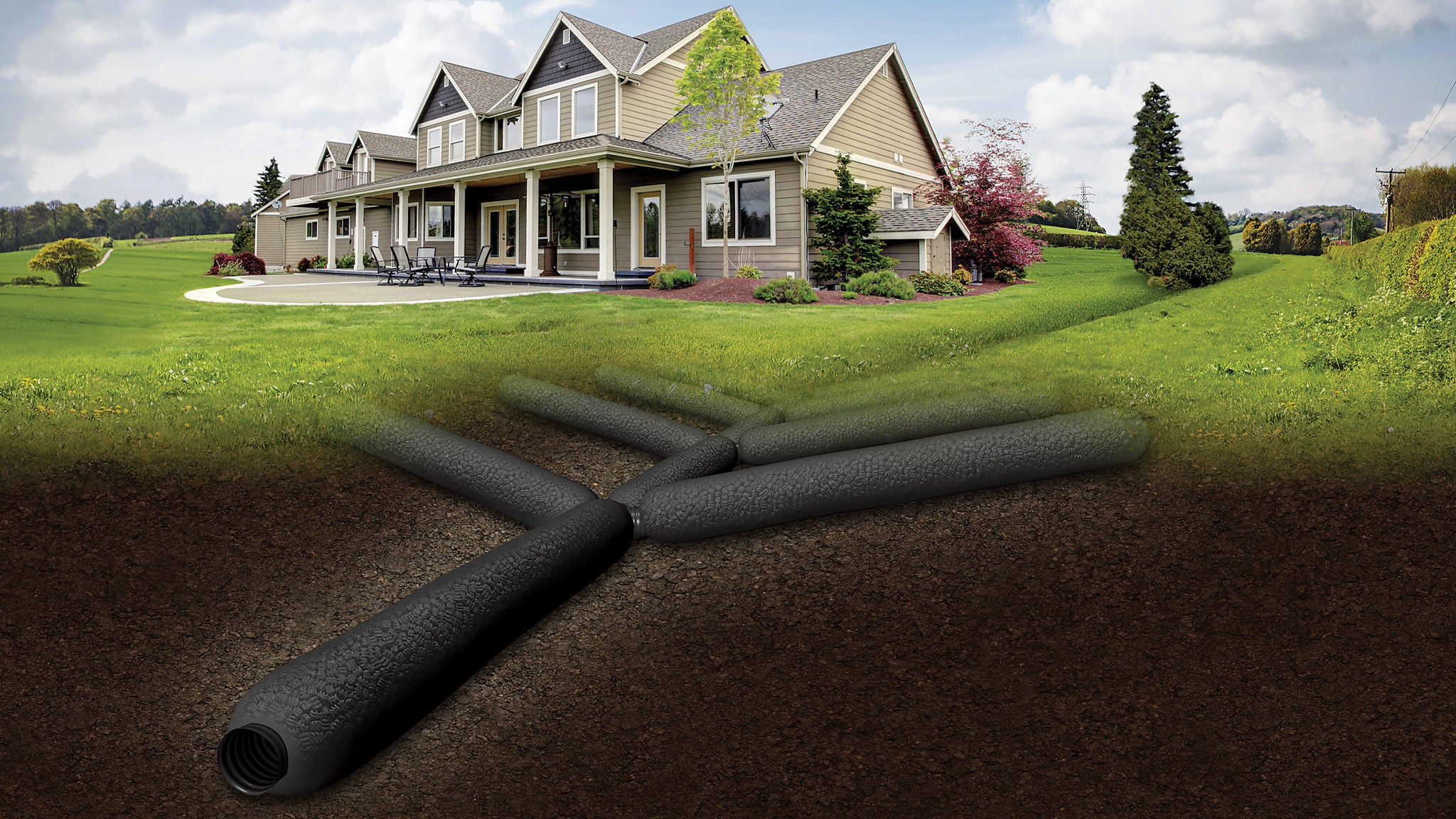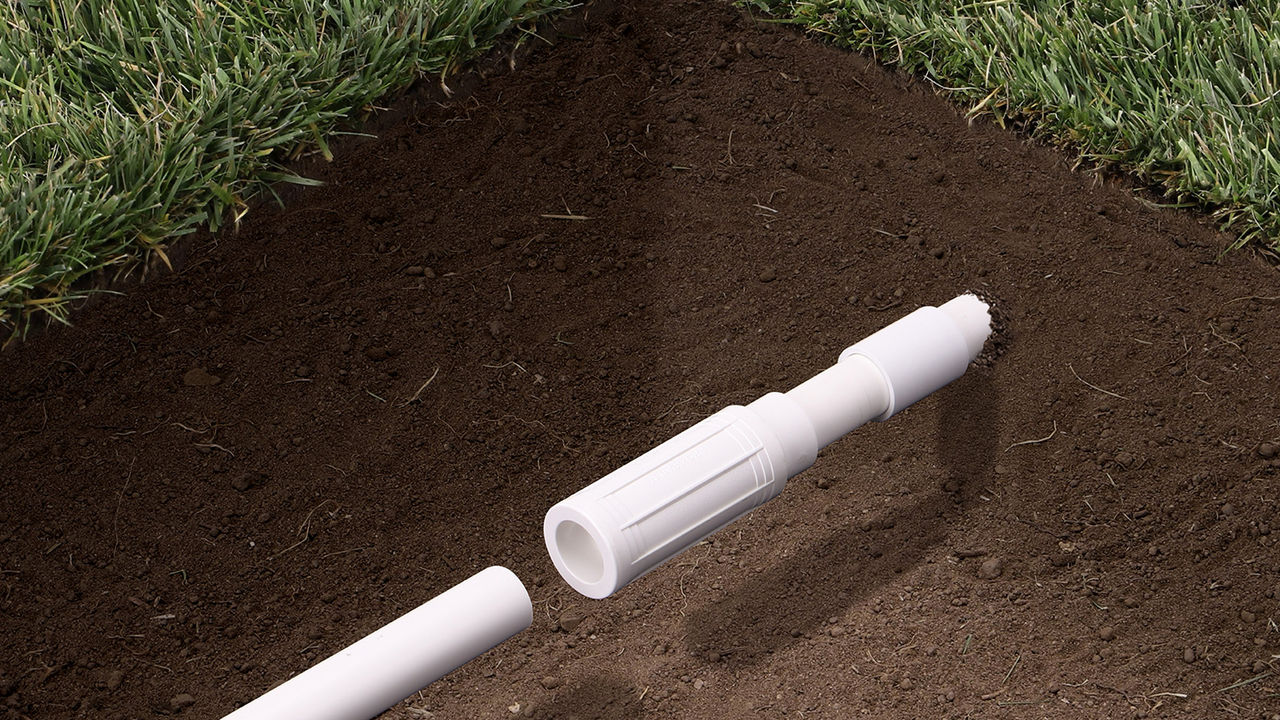By NORMA Group
French Drain Installation Guide

If you're researching French drains, you're probably already facing some drainage issues and looking to learn more about what types of problems a French drain can solve and whether one is right for your property.
Depending on where you live, your home's most important drain may not be located in your kitchen or your bathroom. In fact, it may not be part of your indoor plumbing at all. Instead, your most important drain may be a trench filled with gravel and a perforated pipe in the landscape or next to your home's foundation. While you hardly see it, its role is essential to protecting your home from water damage.
This is the French drain, and if you've never heard of this essential drainage security measure, this webpage is designed to provide you with everything you need to know.
Article Contents
- What is a French Drain?
- How Does a French Drain Work?
- French Drain Pipe Characteristics
- French Drain Cost
- French Drain Applications
- French Drain Design
- French Drain Installation
- Additional Resources
What is a French Drain System?
A French drain, which may also be called a curtain drain, perimeter drain, weeping tile, or agricultural drain, is a gravel-filled trench that includes a perforated or slotted pipe. These drains are used to direct surface water or groundwater away from a specific area, such as a home's foundation. French drains direct surface level water toward the lowest point and allow it to seep through the surface level gravel into the drain. This gravel also blocks the passage of excess debris. The water is then collected in the perforated pipe, running at the base of the drain, and directed away from the home and toward a more suitable area for daylighting or infiltration. French drains differ from typical surface drains because they collect water over the entire length of the drain instead of one particular spot. French drains can also prevent water from collecting and pooling in specific areas, saturating the ground below, which may lead to water problems at the surface or below. Instead, this water is directed to a more desirable location such as a dry well or an area of your choosing. Subsurface drainage systems have been in use for centuries, helping with everything from controlling agricultural runoff to providing yard drainage. They take many forms, but are all similar in design and function to the traditional French drain system. The earliest French drains were simple ditches filled with gravel. While many assume the origins of the French drain date back to France, the drain's name is actually believed to have come from former lawyer and U.S. Assistant Treasury Secretary Henry Flagg French, who popularized them in his 1859 book Farm Drainage. French used sections of roofing tile to create his own drains before later advancements included perforated drains to prevent clogging.
How Does a French Drain Work?
Remember that liquid always seeks out the lowest point it can reach along the easiest path, readily moving into empty pockets in loose soil. That's the secret to a French drain: It provides a reliably easy path, creating a sunken channel that encourages water to percolate out of the surrounding soil and flow along a smooth course. Gravity is essential for a French drain to function properly, as it first forces water down from the surface and out of saturated soil, then pulls it along the downward-sloping pipe to the desired discharge point.
French Drain Pipe Characteristics
One of the most common pipe materials used to create a French drain is plastic because of its durability. There are two frequently chosen pipe variations: corrugated and PVC. Both are lightweight, but corrugated pipe can be flexible, while PVC is stronger and more rigid. Regardless of what the pipe is made of, it must be slotted or perforated at regular intervals to allow water to enter and flow through the system.
Another option for areas that require French drain pipe installation is the EZflow system, which is a pipe that comes already surrounded by an aggregate and fabric mesh. The drain pipe itself is made of high-density polyethylene, and is corrugated and perforated. French drain pipe alternatives such as this one are flexible and come in pre-set lengths, typically of 5 or 10 feet each.
Considering other dimensions is also integral to installing French drain piping, as the pipe's diameter will impact how much water can flow through. A 4-inch diameter perforated French drain pipe is likely adequate for most residential applications, but areas expected to experience a good amount of water collection and heavy soil saturation may require a larger-diameter pipe. Commercial or agricultural uses may also require a larger-diameter perforated pipe for French drain systems.
French Drain Cost
As with any project, estimating the cost of French drain installation should be done before starting work. French drain costs are driven primarily by the materials used, including the piping, aggregate, fabric, couplers, and end caps. There may be other associated permits, fees, or equipment rentals as well. Many professionals figure that a traditional French drain costs about $20 to $30 per foot, but home-built French drain costs may also involve equipment rentals such as a trencher or compactor.
To make a cost estimate, start by figuring out how much of each component you will need. The length of pipe can be determined by measuring the distance from the water collection point to the discharge outlet. Fabric can be determined in a similar way. The amount of gravel needed can be estimated by calculating the length of the trench multiplied by the width and the depth needed to completely cover the pipe. Add the pipe, fabric, and aggregate totals to get the base for an initial installation cost. A french drain calculator can help to more accurately determine the cost of a French drain-type system by tallying up the length of trench required, as well as the number of lengths of pipe necessary to fill that trench.
A French drain installation cost estimate should also factor in labor. Drainage experts are available for hire and charge varying amounts for their work, but even a DIY project can be examined in terms of cost and benefit.
French Drain Applications
French drains are used nationwide by residential, commercial and municipal property owners who face drainage issues that may damage their homes, buildings and property, or limit the usability of lawns and landscaped areas. Since water flows downward along paths of least resistance, it can collect against sunken walls and barriers, where it can degrade the material over time. Then, even a hairline crack can allow the water to gain entry where it isn't wanted, destroying property, creating health hazards, and more. Seepage into a below-ground room, such as a basement or even a crawlspace, can be anything from a nuisance to a major problem.
A French drain is useful in solving drainage problems for:
- Building foundations, basements, and crawlspaces
- Lawns and landscaped areas
- Sports fields, playing fields, and playgrounds
- Hardscape patios and driveways
- Retaining walls
- Any area subject to surface or subsurface saturation
An easy way to site a French drain is to watch where water pools—especially if it sits for hours or days—after a rain. Clay soil can contribute to this problem, as it holds water well. Clay can also clog a French drain system by filtering fine particles into the aggregate, where the particles fill in gaps and prevents water from getting through. For this reason, thinking of the French drain as yet another of its nicknames—the “burrito drain”—can help. A quality burrito, of course, is a tightly wrapped package of various ingredients. Nothing gets in unless you put it there yourself. Similarly, a burrito drain is made up of the necessary components (perforated pipe and aggregate) surrounded by a filter fabric to keep out even fine particles that might accumulate and block the free flow of water.
To help you make an informed decision about whether this method will serve your needs, here are some common drainage problems homeowners face, and how a French drain can reduce or eliminate those problems.
- Flooding in your backyard. If heavy rains have left your yard with an unwanted water feature or the spring thaw has saturated your yard, a French drain can help. Placing a French drain in this wet region allows the drain to collect unwanted water and redirect it to a safer location, giving you back your green space.
- Damage to your outdoor patio. Your patio is a great source of pride and a meeting place for family and friends, but excess water can damage the area, deteriorate the pavers, and also create a breeding ground for mosquitoes, ruining your ability to spend time outdoors. A French drain can work as a shield, collecting water before it reaches the patio and diverting it away. This will eliminate the standing water that mosquitoes need.
- Damage to the foundation and low-level areas like your basement. Check the walls in your basement. If you notice a musty smell or wet floor, you need a French drain immediately. A French drain can stop this water from ever reaching your home, protecting your basement from flooding and your home's foundation from incurring additional damage.
French Drain Design
There are many factors to consider when designing and installing a French drain. Slope is essential, as a downhill course must be downhill enough to keep water running along to its intended destination. Some experts recommend different angles for different types of pipe, such as a 2 percent minimum slope for the corrugated variety. In general, though, a French drain should drop at least 1 percent in depth for every 100 feet of length.
Other elements to consider include:
- French drain depth: About 8 inches to 2 feet deep should be sufficient for many water-diverting projects, though related systems, such as those built around foundations and sub-ground living spaces, as well as the bases of retaining walls, may be deeper.
- French drain aggregate: The size of the gravel used can vary from pea gravel to larger pieces of river rock. If aggregate of different sizes is used, smaller pieces usually go closer to the pipe, while larger pieces sit closer to and on the surface.
- French drain pipe length: This is covered above, and really depends on a project's specific elements. Of course, the pipe should be long enough to carry water from the underground areas where it collects to an end point, where it daylights.
- French drain flow: Slope is a big factor in maintaining a free flow of water, as is the aggregate placement and surrounding fabric to prevent debris from clogging the pipe.
French Drain Installation
Here's a step-by-step guide to installing a French drain on your property.
- Determine the best location. Determining the best location depends on where the problem areas are located, nearby elevation, and the condition of the soil. Use the design tips above to help with siting to ensure proper slope, depth, and more. When it comes to the soil, sandy soil located in an out-of-the way area is preferred, but your installer will find the best solution based on your property's unique features.
- Prepare to dig the French drain. It's your French drain, but it doesn't affect only you. City codes must be considered, and you need to be aware of how your newfound drainage solution will affect your neighbors. This is also an ideal time to contact the local utility company to have any underground lines marked before digging begins. Once you start digging your drain depth will need to be anywhere from eight inches to two feet, depending on your needs and available options.
- Measure the grading. This process begins by pounding two stakes into the ground to mark the dimensions of the trench. A taut string is tied between them, allowing for easy grade measurements as the digging process begins. Regular measuring checks will be performed throughout the process.
- Dig a trench across the slope. Digging the trench is the most labor-intensive portion of the project and as it is being dug, constant grading measurements are necessary. The width of the trench will depend on how large the drainage problem is. Smaller drainage problems can be handled with a trench that is 5 to 6 inches wide, while larger problems will require a larger trench.
- Add the fabric. Once the trench has been dug, it will be lined with landscape fabric, and then additional gravel is added. This fabric prevents dirt from mixing with the gravel and promotes water percolation. Once the fabric has been applied, a light load of gravel is shoveled over the top so the corners of the fabric can be wrapped around this gravel, holding it in place.
- Add pipe. Place a slotted or perforated pipe at the bottom of the trench. The pipe needs to be directed towards an outlet to drain away from the home.
- Fill with gravel. The drain is nearly complete. Now the gravel of whatever size you choose will be shoveled in. Once the gravel is in, top it with another layer of landscape fabric and then cover it with topsoil and new sod.
And that's it, seven easy steps for installing a French drain and eliminating drainage problems at your home.












































































































